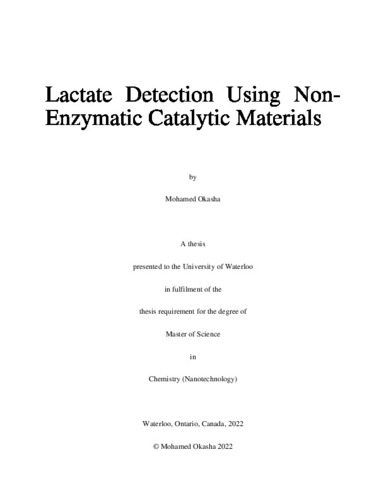| dc.contributor.author | Okasha, Mohamed | |
| dc.date.accessioned | 2022-04-29 20:20:26 (GMT) | |
| dc.date.available | 2023-11-01 04:50:06 (GMT) | |
| dc.date.issued | 2022-04-29 | |
| dc.date.submitted | 2022-04-28 | |
| dc.identifier.uri | http://hdl.handle.net/10012/18210 | |
| dc.description.abstract | An Anastomotic leak (AL) can be defined as the leakage of gastrointestinal fluids into the abdominal cavity at the site of an anastomosis. It is a post-operative complication that affects thousands of patients annually presenting a mortality rate that ranges between 10-15%. Lactate, the conjugate base of lactic acid (LA) is a by-product formed from anaerobic respiration and therefore possesses the potential to be used in the detection of ischemia and ALs if monitored post-surgery. NERv technology Inc., has developed a device aimed at detecting complications post-surgery, with the aim to potentially detect ALs more accurately. The device attaches inline onto surgical drains that are attached post-surgery to drain excess fluid from the abdominal cavity. This device contains micron sized sensors that offer continuous monitoring of the effluent luminal fluid. However, to better detect ischemia in patients and increase likelihood of AL detection, a non-enzymatic catalytic LA sensor is researched and developed with the objective of continuously monitoring LA in isotonic pH conditions. Current LA sensing relies on enzymatic detection, using enzymes such as lactate oxidase (LOD) and lactate dehydrogenase (LDH), which are specific but suffer in terms of stability due to enzyme degradation and denaturation. Current LA detection using non-enzymatic catalytic metals and/or metal oxides can only detect LA through oxidation in either highly acidic or basic media, and although metal and/or metal oxide sensors are theoretically superior to enzymatic sensors, they often fall behind in terms of selectivity. In this work, it is demonstrated that LA detection in isotonic pH can be achieved by using a combination of Pt metal and Ni oxide as a catalyst and co-catalyst in the form of self-assembled nanocomposite chains achieved through the aid of citrate capped gold nanoparticles (AuNP). The nanocomposite comprised of a Au NP core, with a metallic Pt shell and domains of oxidized Ni surrounding the core. The nanocomposite was able to detect positive and negative changes in LA concentrations in real-time in a PBS buffer with decent selectivity and linearity. The nature of the nanocomposite chains can also potentially allow it to be fabricated into a small sensor size, making it theoretically possible to integrate into NERv’s device with further optimization. | en |
| dc.language.iso | en | en |
| dc.publisher | University of Waterloo | en |
| dc.subject | sensors | en |
| dc.subject | lactic acid | en |
| dc.subject | lactate | en |
| dc.subject | anastomotic leaks | en |
| dc.title | Lactate Detection Using Non-Enzymatic Catalytic Materials | en |
| dc.type | Master Thesis | en |
| dc.pending | false | |
| uws-etd.degree.department | Chemistry | en |
| uws-etd.degree.discipline | Chemistry (Nanotechnology) | en |
| uws-etd.degree.grantor | University of Waterloo | en |
| uws-etd.degree | Master of Science | en |
| uws-etd.embargo.terms | 1 year plus 1 week | en |
| uws.contributor.advisor | Maheshwari, Vivek | |
| uws.contributor.affiliation1 | Faculty of Science | en |
| uws.published.city | Waterloo | en |
| uws.published.country | Canada | en |
| uws.published.province | Ontario | en |
| uws.typeOfResource | Text | en |
| uws.peerReviewStatus | Unreviewed | en |
| uws.scholarLevel | Graduate | en |

